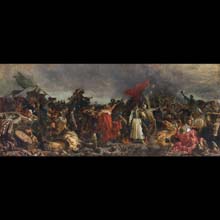
material: oil on canvas
dimensions: 183,5 × 436 cm
description: The 19th century wanted to see Stanisław Żółkiewski as a hero who made Tsars Shuyski bend their heads low before king Sigismund III Vasa. Moreover, the defeat was seen from the angle of the personal courage and honour of the experienced commander. Above all, people remembered his gesture showing absolute faithfulness to his soldiers and the good of Poland even for the price of his life, namely the fact that he had stabbed his horse with a sabre, thus depriving himself of the chance to escape from the battlefield. In the battle of Cecora, which took place on September 19, 1620, the Polish army was defeated by the combined Turkish and Tatar forces. Some of the higher officers had already tried to desert, so in the final clash seventy-three-year-old Żółkiewski, wanting to encourage his soldiers to fight to the end, killed his own horse. Turks found his body the next day. Witold Piwnicki decided to illustrate this moment of the hetman’s life. The large size of the canvas, accuracy in conveying the wealth of objects and attention to historical accuracy are the evidence that the artist wanted to meet the requirements imposed by the academies of fine arts on painters of history works, which were valued most in the academic hierarchy of genres. Barbara Ciciora
exposition: The Gallery of 19th Century Polish Art in Sukiennice,
The Cloth Hall, 1, Main Market Square
key: Around the academy >>>
dimensions: 183,5 × 436 cm
description: The 19th century wanted to see Stanisław Żółkiewski as a hero who made Tsars Shuyski bend their heads low before king Sigismund III Vasa. Moreover, the defeat was seen from the angle of the personal courage and honour of the experienced commander. Above all, people remembered his gesture showing absolute faithfulness to his soldiers and the good of Poland even for the price of his life, namely the fact that he had stabbed his horse with a sabre, thus depriving himself of the chance to escape from the battlefield. In the battle of Cecora, which took place on September 19, 1620, the Polish army was defeated by the combined Turkish and Tatar forces. Some of the higher officers had already tried to desert, so in the final clash seventy-three-year-old Żółkiewski, wanting to encourage his soldiers to fight to the end, killed his own horse. Turks found his body the next day. Witold Piwnicki decided to illustrate this moment of the hetman’s life. The large size of the canvas, accuracy in conveying the wealth of objects and attention to historical accuracy are the evidence that the artist wanted to meet the requirements imposed by the academies of fine arts on painters of history works, which were valued most in the academic hierarchy of genres. Barbara Ciciora
exposition: The Gallery of 19th Century Polish Art in Sukiennice,
The Cloth Hall, 1, Main Market Square
key: Around the academy >>>












